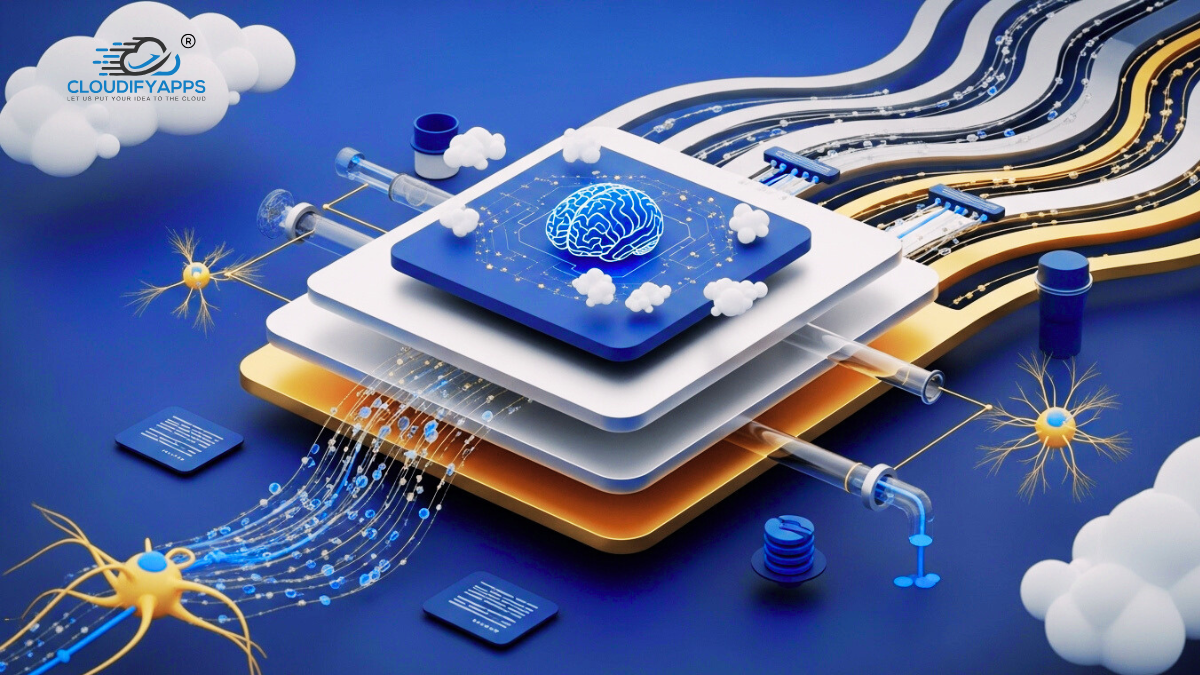
Virtual Reality vs. Augmented Reality - Key Differences and Other Aspects to Know
Introduction
New technology emerged during the 1990s: augmented reality and virtual reality. Our current way of life has developed to rely on these technologies that mix digital life with our traditional methods of life, notably through the use of Augmented and Virtual Realities.
Both AR and VR have enabled us to explore new depths and find parts of modern life that we would not have been able to accomplish otherwise. Both works are based on immersing the user in an immersive experience.
However, there are several distinctions between them, making them two distinct ideas that should not be mistaken. Throughout this blog, we will learn how AR and VR contribute to processes in our everyday lives and the contrasts between the two.
History and Future of Virtual Reality
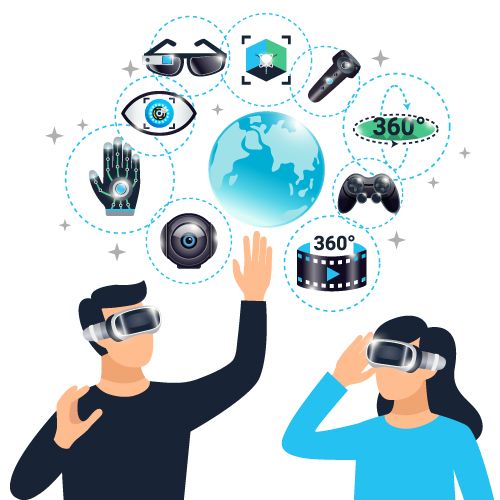
For far longer than the last five to ten years, we've been attempting to capture "Virtual Reality." Peer-through toys were popular in the 1950s, and enclosed flight simulators emerged in the 1960s, but the concept of VR dates back even longer.
Science fiction writers, inventors, and tinkerers dreamed of an atmosphere where you could escape reality via art and machinery as early as the 1930s. But, long before we had the technology to make them conceivable, we debated the merits of Augmented Reality vs Virtual Reality.
Technology has caught up to fiction, and market analysts expect the VR sector to develop rapidly.
What is Augmented Reality(AR)?
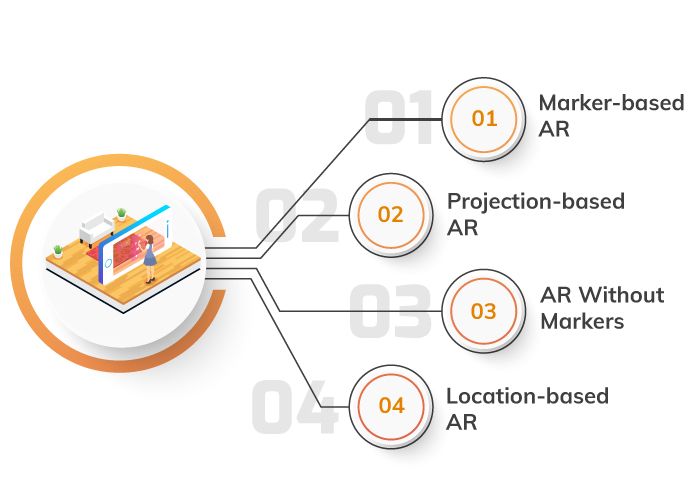
The use of information in the form of text, graphics, music, and other virtual improvements combined with real-world elements in real-time is known as augmented reality. AR is distinguished from virtual reality by its "real world" component. Unlike simulations, AR integrates and adds value to the user's involvement with the actual world.
Essentially, augmented reality (AR) promotes interaction between the actual environment and digital aspects by incorporating real-time information via audio, visuals, 3D objects, and text. Furthermore, AR creates an immersive and engaging user experience by combining technologies like SLAM, object identification, depth tracking, and natural feature tracking.
There are different types of AR, as mentioned below:
Marker-based AR
Target pictures (markers) are used in marker-based AR applications to place items in a particular location. These markers indicate where the 3D digital material will be placed inside the user's field of vision by the program. In the early stages of AR technology, markers were used.
To put it another way, the apps are connected to markers in the real world to superimpose virtual objects on them. As a result, to generate its geometry, the cameras must continually scan the input and establish a marker for picture pattern recognition.
Furthermore, the virtual item will only be displayed if the camera is correctly focused. As a result, a marker-based image identification system necessitates several modules, including a camera, image acquisition, image processing, and marker tracking, among others. However, in general, this is a simple and low-cost approach to implement in filters using a bespoke program to recognize specific patterns captured by a camera.
Instagram and Snapchat, for example, employ augmented reality through filters and games. As a result, this sort of AR is already present in daily life as ordinary social activities.
AR Without Markers
Virtual 3D objects can be positioned in the actual picture environment using markerless AR by analyzing the properties of the data in real time. This form of guidance depends on any smartphone's technology, such as the camera, GPS, or accelerometer, among others, while the augmented reality software does the rest.
Because of current technological breakthroughs in cameras, sensors, and AI algorithms, this paradigm eliminates the requirement for an object-tracking system. As a result, it operates on the digital data collected by these sensors capable of capturing a physical location in real time.
The markerless analysis examines the environment and generates appropriate maps from which virtual items may be inserted utilizing simultaneous localization and mapping (SLAM).
Projection-based AR
This technology allows users to roam freely in an area where a projector and tracking camera are fixed. Projection-based augmented reality (AR) displays digital information in a stationary environment by artificially illuminating a physical surface in regulated settings to provide the sense of depth, direction, and location of an item.
Location-based AR
The goal of location-based markerless AR is to fuse 3D virtual objects in the physical area where the user is located. This technology takes advantage of an intelligent device's location and sensors to position the virtual item in the required size or point of interest.
Pokémon GO is the best example of augmented reality since it employs markerless, location-based AR to bring the user's surroundings to life, depending on where they look.
This augmented reality connects the virtual image to a specific area by reading data in real time from the camera, GPS, compass, and accelerometer. Furthermore, no image trace is necessary for functioning because it is based on markerless AR.
What is Virtual Reality?
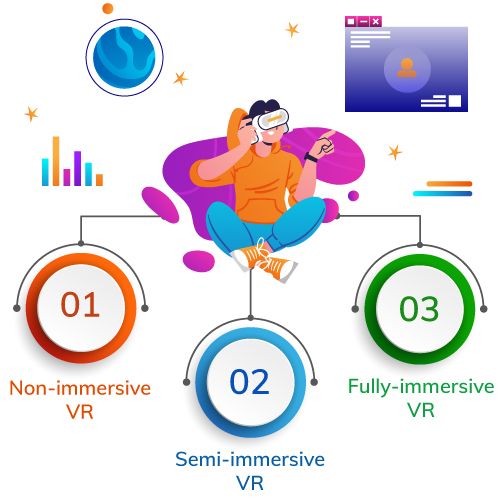
Britannica.com says virtual reality (VR) uses computer modelling and simulation to enable a human to engage with a simulated three-dimensional (3-D) visual or another sensory world. VR applications enable the user to immerse themselves in a high-tech computer-generated environment that appears to be accurate, using interactive devices that send and receive data and are worn as headsets, goggles, gloves, or bodysuits.
Said virtual reality creates a highly participatory and immersive digital user experience. Based on the occasion, it may be divided into three major groups. The three primary forms of virtual reality are as follows:
Non-immersive VR
Because they are so widespread in everyday life, non-immersive virtual experiences are sometimes overlooked as a virtual reality category. This technique creates a computer-generated world while allowing users to be aware of their physical surroundings. Non-immersive virtual reality systems completely rely on a computer or video game console and monitor and input devices such as keyboards, mouse, and controllers.
Semi-immersive VR
People are immersed in a virtual world in semi-immersive virtual experiences. When users focus on the digital image, they will still perceive themselves in a different world but remain linked to their actual environment.
Semi-immersive technology, often known as vertical reality depth, gives realism through 3D visuals. More detailed images create a more immersive experience. This type of VR is frequently employed for educational or teaching reasons. It uses high-resolution screens, powerful computers, projectors, or complicated simulators to reproduce functional real-world machinery's design and operation parts.
Fully-immersive VR
Immersive simulations provide users with the most realistic simulation experience possible, complete with sight and sound. The user must wear VR glasses or sport a head mount display (HMD) to engage with genuinely immersive virtual reality. Virtual reality headsets deliver high-resolution material with a broad field of vision.
The show often divides between the user's eyes, resulting in a stereoscopic 3D effect, and works in tandem with input tracking to create an immersive, convincing experience. This sort of VR has been widely used for gaming and other forms of entertainment, but its use in different fields, particularly education, is growing. The applications for virtual reality are limitless.
Virtual Reality vs Augmented Reality
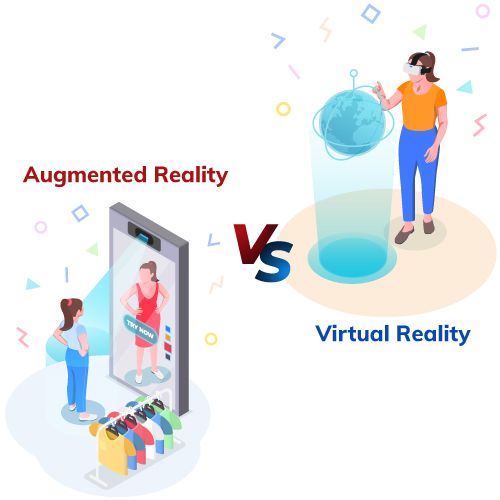
While both AR and VR are intended to present consumers with a simulated computer-generated 3D experience, each technology is distinct and has its applications. So, what is the primary distinction between AR and VR?
The main difference is that VR seeks to replace the actual world with absolute immersion. In contrast, AR aims to overlay the virtual by projecting digital information on top of the user's current environment.
Furthermore, because VR tends toward complete immersion, devices must isolate users from the actual world by restricting their field of view to deliver VR material. As a result, VR is best experienced with specialized equipment such as gloves or a VR headset.
The Level of Immersion in Virtual Reality As Opposed to Augmented Reality
The user is entirely immersed in a virtual environment in VR, minimizing borders and markers. The system creates everything in the user's environment, which may be displayed within an empty room using head-mounted displays (HMDs) or other technology that makes users feel physically inside the virtual world.
However, with augmented reality, real-world surroundings are layered with digital features, and the user may still interact with the real and virtual worlds.
Differences in the Physics of AR and VR
AR uses computer vision, mapping, and depth sensing to display relevant content to the user. In contrast, VR uses cameras to capture, transmit, and analyze data to demonstrate digital material pertinent to the user's field of view.
Two lenses are placed between the screens in virtual reality. Depending on the unique movement of each eye, the user must adapt the lenses using eye-tracking technology. Users can construct an immersive world by combining visual, audio, and haptic (touch) inputs.
Differences in the Hardware Used in AR and VR
Mobile AR with Feature Tracking is the most accessible sort of Augmented Reality today. You can get started with it on most recent smartphones and tablets by leveraging IMU data and that gorgeous RGB camera.
There are two techniques for mobile AR: marker-based tracking and marker-less tracking. Marker tracking often entails inserting a QR code or other predictable pattern that the program recognizes, tracking it on the fly, and overlaying CG objects. Mobile AR with Depth Sensors — Structured Light, Stereo Cam, and ToF is a significantly more robust method since the software has a far deeper grasp (pun intended) of the environment around you and your relative location, thanks to really slick SLAM algorithms.
As you explore, SLAM creates a model of the 3D space around you.
Mobile VR essentially transforms your smartphone into a head-mounted display (HMD).
Consider it a teaser for high-end VR and a terrific way to passively consume material — 360 films and photographs or chillin' in front of the most spectacular fireplace with your friends watching Netflix. Because many people have pretty fast smartphones, the cost of entry into Mobile VR is exceptionally inexpensive. Phones with 4K screens can watch passive material with the same clarity as their more costly counterparts.
Most significantly, there are no wires involved! Today's disadvantage of mobile VR is that it is restricted to three degrees of freedom (3DOF in short). You can stare (or swivel) around differently, but you can't lean or move your head around as in real life (no parallax). Mobile also requires us to optimize experiences so they degrade gracefully on slower mobile hardware.
Various Degrees of Adaptability and Application cases
Another significant distinction between AR and VR is how the two technologies are applied. AR gives the customer more alternatives, is preferred for businesses looking for unique use cases and is more widely used because it frequently tethers to a mobile smartphone rather than computers or more giant machines.
Conversely, VR combines near-complete immersion and real-time 3D (RT3D) material and is an excellent technique for delivering secure and safe training scenarios for employees who operate in high-risk schemes. For example, BP collaborated with Igloo Vision to train personnel at English oil refineries on emergency evacuation techniques.
AR use cases, on the other hand, entail sharing knowledge in a hands-on style. Field staff, for example, may obtain vital data overlays from remote advisors while working to fix issues precisely without requiring additional support.
Various Developer Experiences
VR software development kits (SDKs) also enable apps to broadcast pre-loaded or cloud-based situations for users to navigate utilizing VR headsets and controllers. In addition, user and environment tracking, enabled by sensors, haptics, cameras, and other technologies, enables navigation and environmental control.
SDKs like ARKit, Vuforia, Wikitude, ARCore, ARToolKit, and Spark AR Studio dominate the market and enable developers to add real-time user contexts to their apps.
Differences in the Bandwidth Needs
In the approaching digital era of consumer electronics, augmented reality (AR) and also virtual reality (VR) technologies are predicted to become widely available, with potential applications for producing a wide range of use cases. AR will play various roles in daily life, while VR with live gaming will elevate the user experience to a new level. As a result, VR and AR will increase bandwidth demand, posing several issues to Internet service providers using outdated technology.
To meet these needs, ISPs must provide high-capacity symmetrical bandwidth, consistent internet speed with minimal latency, and IPv6 connection to supply rich visual content for VR-enabled electronic devices. On a contract, AR will demand up to 100Mbps, and VR will require up to 25Mbps.
Mixed Reality (MR)- The Mixed Future
Mixed reality (MR) refers to a mixture of AR and VR, mixing virtual and physical surroundings to create a new environment in which real-time interactions between virtual and actual goods are possible.
MR systems constantly collect further information about the environment and what is happening within it, as opposed to VR systems, which immerse users in entirely virtual worlds, or AR, which overlays digital content on top of the natural world without considering its unique dynamic structure. MR connects the virtual and real worlds, making them interconnected.
MR is a field that is rapidly expanding. MR applications have been applied in various industries, including entertainment, education, design, healthcare, military training, marketing, and remote working. Furthermore, the phenomena of AR, VR, and MR are closely intertwined with extended reality (XR). XR incorporates all digital and physical elements and human-machine interactions via wearables such as headsets and smartphones.
Benefits of Virtual Reality:
● Virtual reality is more immersive than augmented reality in terms of immersion and a virtual sensation of presence.
● There are several uses.
● For streaming 360-degree resolution movies, Retina-quality films, and 4K resolution, less bandwidth is required than for AR.
Benefits of Augmented Reality:
● Because there is no need for a head-mounted display, AR gives users greater flexibility and advertisers more options.
● AR has a more significant market potential than VR and has been increasing quicker in recent years as big businesses have begun to use it.
● There are several uses.
● Device constraints have less of an impact on AR. However, it is still necessary to build high-resolution, life-like things.
VR and AR Job Opportunities
These new, growing technologies provide limitless prospects for businesses and employment—the AR and VR industry is expected to reach $209.2 billion by 2022. Through software and hardware development, research, graphic design, and other means, VR and AR are altering businesses.
Jobs creating and upgrading VR and AR technologies include:
● Engineering and development of software
● Project administration
● Software maintenance
● Graphic design
Final Words
It needs to be corrected to state that Augmented Reality and Virtual Reality are meant to work independently. However, when these technologies are combined to transport the user to the imaginary world by providing a new level of interaction between the actual and virtual worlds, they produce a better engaging experience. The point of time when the two experiences coincide creates a feeling that is highly overwhelming, considering our day-to-day environment.
Popular Tags
Recent Posts
Smart automation for cash-strapped startups
The modern data trinity: How medallion architecture, RAG, and data lakes revolutionize enterprise intelligence
Accelerating AI-Driven Development with Docker’s MCP Catalog & Toolkit
Building Intelligent Agent Teams with Google's ADK: A Developer's Guide
We are at





















